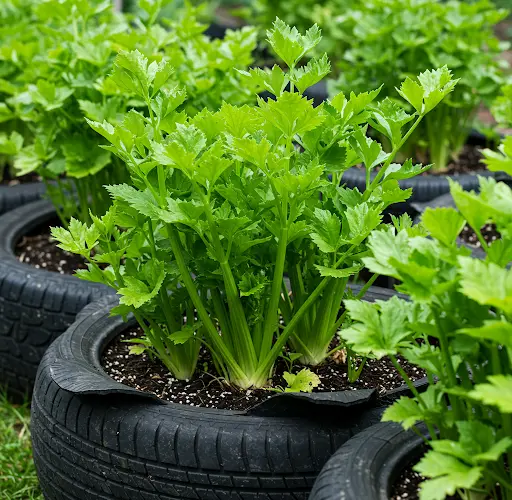Growing your own vegetables is one of the most rewarding and cost-effective ways to ensure access to fresh, organic produce. Celery, a nutritious and versatile vegetable, may seem difficult to grow for beginners. However, with a bit of creativity and the use of recycled tires, anyone can grow crisp, healthy celery even in limited spaces. This article explores an easy, eco-friendly method to grow celery in old tires—a perfect solution for urban gardeners or those with small yards.
Why Grow Celery in Tires?
Old tires, often seen as waste, can be transformed into compact, productive garden beds. They offer a unique advantage for celery growers:
-
Heat retention: The rubber material helps warm the soil, aiding root development.
-
Moisture control: Tires hold moisture well, preventing the celery from drying out.
-
Space-saving: Stackable and compact, tires are ideal for vertical or balcony gardening.
-
Eco-friendly: Repurposing tires helps reduce landfill waste while creating productive growing spaces.
Celery is a moisture-loving plant with shallow roots, which makes the confined, moisture-retentive space of a tire perfect for its growth.
What You’ll Need
Before you begin, gather the following materials:
-
1–2 recycled tires (cleaned and pesticide-free)
-
High-quality potting soil or a mix of compost, coconut coir, and garden soil
-
Celery seeds or seedlings
-
Organic fertilizer (compost, compost tea, or worm castings)
-
Mulch (straw, dried leaves, or rice husk)
-
A sunny location (4–6 hours of light daily)
-
Watering can or drip system
Step-by-Step Guide to Growing Celery in Tires
1. Prepare the Tire Bed
Place one or more tires in a sunny location. If stacking more than one tire, make sure they’re stable and secure. Line the bottom of the tire with a piece of burlap or mesh if needed to prevent soil from falling out. Fill the inside with rich, loose soil, leaving a small space at the top to allow for watering.
2. Sow Celery Seeds or Transplant Seedlings
Celery can be started from seeds or from store-bought celery bases. If starting from seed, soak the seeds in warm water overnight for better germination. Sow them thinly on the surface and lightly press them into the soil—celery seeds need light to germinate.
Alternatively, you can regrow celery by placing the cut base of a celery bunch in water until new shoots emerge, then transplant it into the tire bed.
If transplanting seedlings, space them about 6–8 inches apart to allow enough room for stalk growth.
3. Water Consistently
Celery requires consistent moisture to grow juicy, tender stalks. Water regularly, ensuring the soil stays evenly moist but not waterlogged. In dry or hot climates, you may need to water twice a day.
To improve water retention, apply a layer of mulch around the plants. This helps keep the roots cool and reduces the frequency of watering.
4. Feed Organically
Fertilize every 2–3 weeks with organic compost or diluted compost tea. Celery is a heavy feeder and responds well to regular nourishment. Fish emulsion, banana peel fertilizer, or crushed eggshells can also be added for added potassium and calcium.
Maintenance Tips
-
Weeding: Keep the tire bed free of weeds to reduce competition for nutrients.
-
Pest control: Celery can attract aphids and slugs. Use natural deterrents like neem oil, garlic spray, or introduce beneficial insects like ladybugs.
-
Support stalks: As stalks mature, they may flop over. Use soft ties or garden twine to gently support them.
-
Blanching (Optional): For a milder flavor, mound soil or wrap the base of the stalks with newspaper for the last two weeks before harvest.
Harvesting Celery
Celery is typically ready for harvest 90–120 days after planting. You can cut individual stalks as needed or harvest the entire plant by slicing at the soil line. For a continuous supply, leave the base intact—it may regrow multiple times under the right conditions.
For best flavor and texture, harvest when stalks are about 8–10 inches tall and firm.
Health Benefits of Homegrown Celery
Celery is rich in antioxidants, vitamins A, C, and K, and supports digestion, hydration, and heart health. When grown at home without synthetic chemicals, it retains its full nutrient profile and is free from harmful residues often found in store-bought varieties.
Conclusion
Growing celery in recycled tires is not just easy—it’s sustainable, economical, and incredibly rewarding. Even if you lack garden space, a few old tires and some good soil are all you need to enjoy a steady supply of crisp, nutritious celery. Whether you’re gardening on a balcony, patio, or rooftop, this method lets you turn trash into treasure—and enjoy the health benefits of fresh vegetables all year long.



